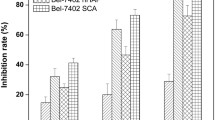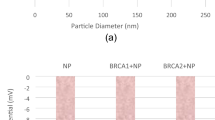Abstract
This research focused on anti-tumor effect of pEGFP-C1-p53 (p53) gene-loaded hydroxyapatite (HAp) nanoparticles in vitro and in vivo. Four kinds of HAp nanoparticles, spherical HAp nanoparticles (S-HAp, diameter: 50 nm), needle-like HAp nanoparticles (N-HAp, average length: 110 nm and width: 30 nm), rod-like HAp nanoparticles (R-HAp, average length: 100 nm and width: 30 nm), and short-rod-like HAp nanoparticles (SR-HAp, average length: 40 nm and width: 30 nm), were prepared initially. The HAp nanoparticles with or without being modified by PEI (named HAp and HAp-PEI, respectively) have excellent biocompatibility as shown by MTT assay and crystal violet staining tests. Then, the subsequent MTT, Hocehst staining tests, and Western blot showed that the killing effect of p53-loaded HAp-PEI (HAp-PEI-p53) was effective with fair selectivity toward Hep-3B and HuH-7 cells’ cell lines. Moreover, HAp-PEI-p53 could inhibit the tumor growth in vivo, and the mechanism of tumor growth inhibition was verified by the hematoxylin and eosin staining, terminal deoxynucleotidyl transferase-mediated dUTP nick-end labeling, P53 protein immunohistochemistry, and transmission electron microscope of the tumor cell in vivo. We found that HAp-PEI-p53 has good anti-cancer effect in vitro and in vivo, especially for the S-HAp-PEI-p53. Tumor metastasis could be suppressed significantly by the S-HAp-PEI-p53 and N-HAp-PEI-p53 treatments by the in vivo imaging system. All these results lead to the conclusion that the particle sizes of HAp ranging from 100 to 200 nm are appropriate for cancer gene therapy and may be widely used in anti-cancer investigation.







Similar content being viewed by others
References
Bisht S, Bhakta G, Mitra S, Maitra A (2005) pDNA loaded calcium phosphate nanoparticles: highly efficient non-viral vector for gene delivery. Int J Pharm 288(1):157–168. doi:10.1016/j.ijpharm.2004.07.035
Cai Y, Liu Y, Yan W, Hu Q, Tao J, Zhang M, Shi Z, Tang R (2007) Role of hydroxyapatite nanoparticle size in bone cell proliferation. J Mater Chem 17(36):3780–3787. doi:10.1039/b705129h
Cao X, Deng WW, Qu R, Yu QT, Li J, Yang Y, Cao Y, Gao XD, Xu XM, Yu JN (2013) Non-viral co-delivery of the four Yamanaka factors for generation of human induced pluripotent stem cells via calcium phosphate nanocomposite particles. Adv Funct Mater 23(43):5403–5411. doi:10.1002/adfm.201203646
Chen L, Mccrate JM, Lee JC, Li H (2011) The role of surface charge on the uptake and biocompatibility of hydroxyapatite nanoparticles with osteoblast cells. Nanotechnology 22(10):1–10. doi:10.1088/0957-4484/22/10/105708
Davis ME (2002) Non-viral gene delivery systems. Curr Opin Biotechnol 13(2):128–131. doi:10.1016/S0958-1669(02)00294-X
Donaldson K, Tran CL (2002) Inflammation caused by particles and fibers. Inhal Toxicol 14(1):5–27. doi:10.1080/089583701753338613
Ehrhardt C, Schmolke M, Matzke A, Knoblauch A, Will C, Wixler V, Ludwig S (2006) Polyethylenimine, a cost-effective transfection reagent. Signal Transduct 6(3):179–184. doi:10.1002/sita.200500073
Elangovan S, Jain S, Tsai PC, Margolis HC, Amiji M (2013) Nano-sized calcium phosphate particles for periodontal gene therapy. J Periodontol 84(1):117–125. doi:10.1902/jop.2012.120012
Fu C, Lin L, Shi H, Zheng D, Wang W, Gao S, Zhao Y, Tian H, Zhu X, Chen X (2012) Hydrophobic poly (amino acid) modified PEI mediated delivery of rev-casp-3 for cancer therapy. Biomaterials 33(18):4589–4596. doi:10.1016/j.biomaterials.2012.02.057
Gao H, Shi W, Freund LB (2005) Mechanics of receptor-mediated endocytosis. PNAS 102(27):9469–9474. doi:10.1073/pnas.0503879102
Ginn SL, Alexander IE, Edelstein ML, Abedi MR, Wixon J (2013) Gene therapy clinical trials worldwide to 2012—an update. J Gene Med 15(2):65–77. doi:10.1002/jgm.2698
Hacein-Bey-Abina S, Von Kalle C, Schmidt M, McCormack M, Wulffraat N, Leboulch P, Lim A, Osborne C, Pawliuk R, Morillon E (2003) LMO2-associated clonal T cell proliferation in two patients after gene therapy for SCID-X1. Science 302(5644):415–419. doi:10.1126/science.1088547
Hagiwara K, Kishimoto S, Ishihara M, Koyama Y, Mazda O, Sato T (2013) In vivo gene transfer using pDNA/chitosan/chondroitin sulfate ternary complexes: influence of chondroitin sulfate on the stability of freeze-dried complexes and transgene expression in vivo. J Gene Med 15(2):83–92. doi:10.1002/jgm.2694
Hahn B-D, Lee J-M, Park D-S, Choi J–J, Ryu J, Yoon W-H, Choi J-H, Lee B-K, Kim J-W, Kim H-E (2011) Enhanced bioactivity and biocompatibility of nanostructured hydroxyapatite coating by hydrothermal annealing. Thin Solid Films 519(22):8085–8090. doi:10.1016/j.tsf.2011.07.008
Howe SJ, Mansour MR, Schwarzwaelder K, Bartholomae C, Hubank M, Kempski H, Brugman MH, Pike-Overzet K, Chatters SJ, de Ridder D, Gilmour KC, Adams S, Thornhill SI, Parsley KL, Staal FJT, Gale RE, Linch DC, Bayford J, Brown L, Quaye M, Kinnon C, Ancliff P, Webb DK, Schmidt M, von Kalle C, Gaspar HB, Thrasher AJ (2008) Insertional mutagenesis combined with acquired somatic mutations causes leukemogenesis following gene therapy of SCID-X1 patients. J Clin Invest 118(9):3143–3150. doi:10.1172/JCI35798
Kong X, Xu S, Wang X, Cui F, Yao J (2012) Calcium carbonate microparticles used as a gene vector for delivering p53 gene into cancer cells. J Biomed Mater Res 100(9):2312–2318. doi:10.1002/jbm.a.34155
Kumta PN, Sfeir C, Lee DH, Olton D, Choi D (2005) Nanostructured calcium phosphates for biomedical applications: novel synthesis and characterization. Acta Biomater 1(1):65–83. doi:10.1016/j.actbio.2004.09.008
Lee D, Upadhye K, Kumta PN (2012) Nano-sized calcium phosphate (CaP) carriers for non-viral gene delivery. Mater Sci Eng B 177(3):289–302. doi:10.1016/j.mseb.2011.11.001
Li J, Chen YC, Tseng YC, Mozumdar S, Huang L (2010) Biodegradable calcium phosphate nanoparticle with lipid coating for systemic siRNA delivery. J Control Release 142(3):416–421. doi:10.1016/j.jconrel.2009.11.008
Lin W, Huang YW, Zhou XD, Ma Y (2006) In vitro toxicity of silica nanoparticles in human lung cancer cells. Toxicol Appl Pharmacol 217(3):252–259. doi:10.1016/j.taap.2006.10.004
Lu X, Wang Q, Xu F, Tang G, Yang W (2011) A cationic prodrug/therapeutic gene nanocomplex for the synergistic treatment of tumors. Biomaterials 32(21):4849–4856. doi:10.1016/j.biomaterials.2011.03.022
Maitra A (2005) Calcium phosphate nanoparticles: second-generation nonviral vectors in gene therapy. Expert Rev Mol Diagn 5(6):505–893. doi:10.1586/14737159.5.6.893
Motskin M, Wright D, Muller K, Kyle N, Gard T, Porter A, Skepper J (2009) Hydroxyapatite nano and microparticles: correlation of particle properties with cytotoxicity and biostability. Biomaterials 30(19):3307–3317. doi:10.1016/j.biomaterials.2009.02.044
Murakami Y, Sugo K, Hirano M, Okuyama T (2011) Surface chemical analysis and chromatographic characterization of polyethylenimine-coated hydroxyapatite with various amount of polyethylenimine. Talanta 85(3):1298–1303. doi:10.1016/j.talanta.2011.06.004
Muruve DA (2004) The innate immune response to adenovirus vectors. Hum Gene Ther 15(12):1157–1166. doi:10.1089/hum.2004.15.1157
Nayak S, Herzog RW (2009) Progress and prospects: immune responses to viral vectors. Gene Ther 17(3):295–304. doi:10.1038/gt.2009.148
Oberdürster G (2000) Toxicology of ultrafine particles: in vivo studies. Philos Trans R Soc A 358(1775):2719–2740. doi:10.1098/rsta.2000.0680
Panyam J, Labhasetwar V (2012) Biodegradable nanoparticles for drug and gene delivery to cells and tissue. Adv Drug Deliv Rev 64:61–71. doi:10.1016/S0169-409X(02)00228-4
Pittella F, Miyata K, Maeda Y, Suma T, Watanabe S, Chen Q, Christie RJ, Osada K, Nishiyama N, Kataoka K (2012) Pancreatic cancer therapy by systemic administration of VEGF siRNA contained in calcium phosphate/charge-conversional polymer hybrid nanoparticles. J Control Release 161(3):868–874. doi:10.1016/j.jconrel.2012.05.005
Raja MAG, Katas H, Abd Hamid Z, Razali NA (2013) Physicochemical properties and in vitro cytotoxicity studies of chitosan as a potential carrier for dicer-substrate siRNA. J Nanomater. doi:10.1155/2013/653892
Raper SE, Chirmule N, Lee FS, Wivel NA, Bagg A, Gao GP, Wilson JM, Batshaw ML (2003) Fatal systemic inflammatory response syndrome in a ornithine transcarbamylase deficient patient following adenoviral gene transfer. Mol Genet Metab 80(1–2):148–158. doi:10.1016/j.ymgme.2003.08.016
Shen H, Mittal V, Ferrari M, Chang J (2013) Delivery of gene silencing agents for breast cancer therapy. Breast Cancer Res 15(3):1–10. doi:10.1186/bcr3413
Sokolova V, Rotan O, Klesing J, Nalbant P, Buer J, Knuschke T, Westendorf AM, Epple M (2012) Calcium phosphate nanoparticles as versatile carrier for small and large molecules across cell membranes. J Nanopart Res 14(6):1–10. doi:10.1007/s11051-012-0910-9
Sun Y, Li XY, Liang XF, Wan ZY, Duan YR (2013) Calcium phosphate/octadecyl-quatemized carboxymethyl Chitosan nanoparticles: an efficient and promising carrier for gene transfection. J Nanosci Nanotechnol 13(8):5260–5266. doi:10.1166/jnn.2013.7529
Tobin LA, Xie YL, Tsokos M, Chung SI, Merz AA, Arnold MA, Li G, Malech HL, Kwong KF (2013) Pegylated siRNA-loaded calcium phosphate nanoparticle-driven amplification of cancer cell internalization in vivo. Biomaterials 34(12):2980–2990. doi:10.1016/j.biomaterials.2013.01.046
Wang SB, Tan Y, Lei W, Wang YG, Zhou XM, Jia XY, Zhang KJ, Chu L, Liu XY, Qian WB (2012) Complete Eradication of Xenograft Hepatoma by Oncolytic Adenovirus ZD55 Harboring TRAIL-IETD-Smac Gene with Broad Antitumor Effect. Hum Gene Ther 23(9):992–1002. doi:10.1089/hum.2011.159
Wu X, Ding D, Jiang H, Xing X, Huang S, Liu H, Chen Z, Sun H (2012) Transfection using hydroxyapatite nanoparticles in the inner ear via an intact round window membrane in chinchilla. J Nanopart Res 14(1):1–13. doi:10.1007/s11051-011-0708-1
Yang J, Lam DH, Goh SS, Lee EX, Zhao Y, Tay FC, Chen C, Du S, Balasundaram G, Shahbazi M (2012) Tumor tropism of intravenously injected human-induced pluripotent stem cell-derived neural stem cells and their gene therapy application in a metastatic breast cancer model. Stem Cells 30(5):1021–1029. doi:10.1002/stem.1051
Yuan Y, Liu C, Qian J, Wang J, Zhang Y (2010) Size-mediated cytotoxicity and apoptosis of hydroxyapatite nanoparticles in human hepatoma HepG2 cells. Biomaterials 31(4):730–740. doi:10.1016/j.biomaterials.2009.09.088
Zhan M, Yu D, Lang A, Li L, Pollock RE (2001) Wild type p53 sensitizes soft tissue sarcoma cells to doxorubicin by down-regulating multidrug resistance-1 expression. Cancer 92(6):1556–1566. doi:10.1002/1097-0142
Zhao Y, Zhang Y, Ning F, Guo D, Xu Z (2007) Synthesis and cellular biocompatibility of two kinds of HAP with different nanocrystal morphology. J Biomed Mater Res B 83(1):121–126. doi:10.1002/jbm.b.30774
Zhao D, Zhuo RX, Cheng SX (2012) Alginate modified nanostructured calcium carbonate with enhanced delivery efficiency for gene and drug delivery. Mol Biosyst 3:753–759. doi:10.1039/c1mb05337j
Zhu S, Huang B, Zhou K, Huang S, Liu F, Li Y, Xue Z, Long Z (2004) Hydroxyapatite nanoparticles as a novel gene carrier. J Nanopart Res 6(2):307–311. doi:10.1023/b:nano.0000034721.06473.23
Acknowledgments
This work was supported by Grants from the National Natural Science Foundation of China (51272236, 51002139), the Natural Science Foundation of Zhejiang Province (Y207217), and the Program for 521 Excellent Talents of Zhejiang Sci-Tech University.
Author information
Authors and Affiliations
Corresponding author
Rights and permissions
About this article
Cite this article
Zhao, R., Yang, X., Chen, C. et al. The anti-tumor effect of p53 gene-loaded hydroxyapatite nanoparticles in vitro and in vivo. J Nanopart Res 16, 2353 (2014). https://doi.org/10.1007/s11051-014-2353-y
Received:
Accepted:
Published:
DOI: https://doi.org/10.1007/s11051-014-2353-y




